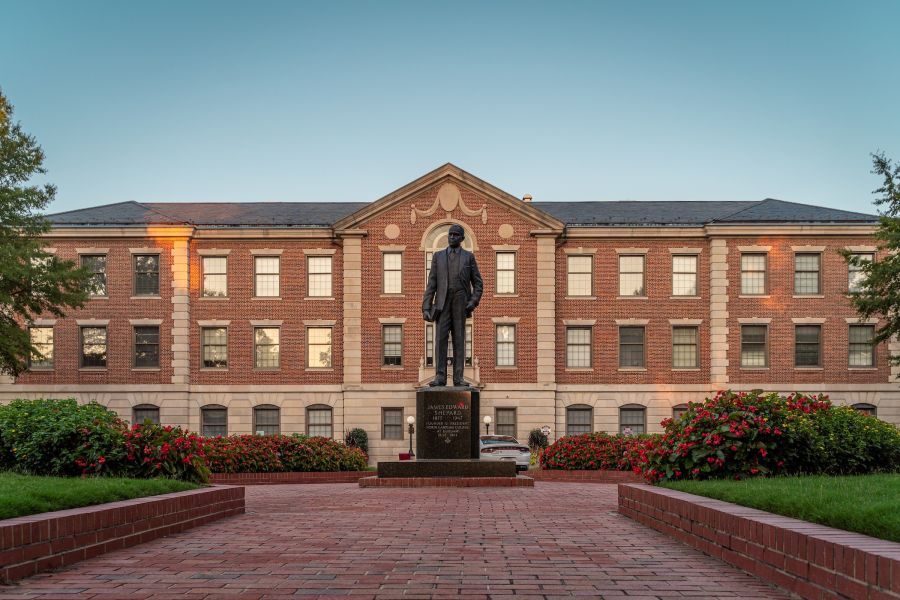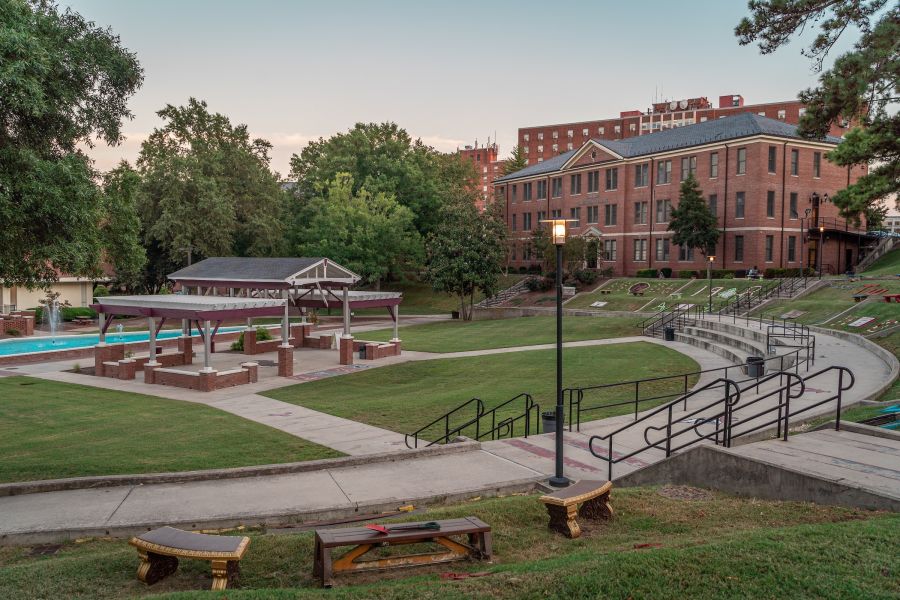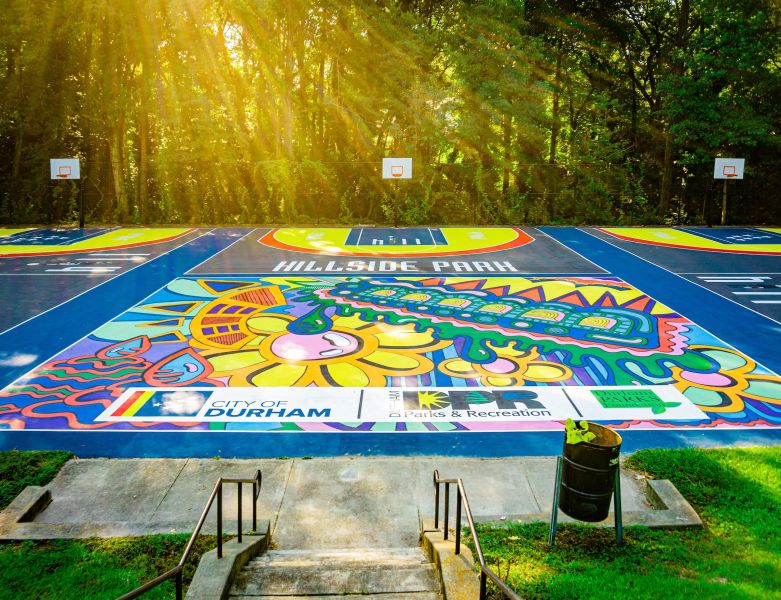A Visitor's Guide to NCCU & Fayetteville Street
Experience the energy of the first state-supported liberal arts HBCU at North Carolina Central University's campus, and immerse yourself in the history and culture of the surrounding neighborhood.
Whether you’re visiting as a new or returning North Carolina Central University Eagle or looking to soak up the history and energy of campus and the surrounding neighborhood, there’s plenty to do, see and experience on campus and around the historic Fayetteville Street corridor.
Historic Roots
In 1910, Dr. James E. Shepard founded the National Religious Training School and Chautauqua for the Colored Race. The school would become North Carolina Central University, the first state-supported liberal arts college for Black students. An educator, civil servant, pharmacist, and businessman, Shepard was one of the first seven investors in North Carolina Mutual Life Insurance Company and assisted with the incorporation of Mechanics and Farmers Bank, original anchors of Durham’s Black Wall Street and two of the largest and longest-running Black-owned companies in the nation. Shepard is thought to be one of the most successful and affluent African Americans in the United States in the early 1900s and was committed to developing in young men and women “that fine character and sound academic training requisite for real service to the nation.”
Tributes to his service to the school, where he served as president until his death in 1947, stand across campus, which spans the area between Fayetteville Street and Alston Avenue for several blocks south of E. Lawson Street, just south of the Hayti Heritage Center. The Dr. James Shepard House on the corner of Brant and Fayetteville Streets displays interactive exhibits on the life and work of Dr. Shepard and hosts private events. The life-size, bronze James E. Shepard statue represents his lasting impact in the center of campus and he’s remembered on the main library on campus, The James E. Shepard Memorial Library.

The James E. Shepard Statue on NCCU campus. Photo: Discover Durham
Explore Campus and Community
With undergraduate degrees in dozens of disciplines, master’s programs in more than 40 areas and a Ph.D. in Integrated Biosciences, graduates from the university’s seven colleges and schools share their impact globally. And since NCCU was the first state-supported university in North Carolina to require community service as a graduation requirement, its historical ties to the surrounding neighborhood and the City of Durham remain strong.
A visit to campus starts with the brand new, state-of-the-art Student Center. This student hub and community space invites visitors to lounge on its sprawling lawn, meet in its light-filled lobby, and gather in its auditoriums and spaces for public and private events. Stop here to take in the beauty of the campus’s newest addition and get the lay of the land before you continue.
Greek Bowl is your stop for a true college vibe. The circular gathering space is the iconic campus “quad” where students gather to socialize and study between classes. Pause here to reflect on the history and significance of this place.

Greek Bowl in the center of NCCU campus. Photo: Discover Durham
Continue across campus to visit the Art Museum’s permanent collection of African American and African art, which reflects the University’s African American art history and traditional art history courses. Then, find your way to the Farrison-Newton Communications Building to inspire your inner broadcast journalist at the state-of-the-art television studio where students produce the live show “Central News,” which provides news updates impacting the campus community.
Finally, experience an unforgettable tradition during Homecoming in the fall when alumni and students gather for celebrations and events across campus. Take in a parade, tailgate for an Eagles game at O’Kelly-Riddick Stadium and immerse yourself in campus culture with week-long festivities. Eagle pride is especially high since the 2022 team won the HBCU national championship. Hear coach Trei Oliver’s reflections on the big win and learn about what led him and the team to this proud moment on our podcast episode.
Discover Historic Neighborhoods
Fayetteville Street District
The western edge of NCCU’s campus is bordered by Fayetteville Street, serving as the de facto Main Street of the Hayti Neighborhood and connecting it to South Durham. South of the significant Hayti intersection of Fayetteville and Pettigrew streets, an eclectic mix of residential and commercial buildings and community remain emblematic of the historic neighborhood. A look at Durham’s history reveals that this corridor was once home to grand Queen Anne, Colonial Revival and Tudor Revival homes built by some of Durham’s most prominent Black residents. Many of these homes did not survive urban renewal in the 1960s and ‘70s when Durham Freeway construction obliterated the Fayetteville-Pettigrew corner and cleared and rerouted Fayetteville Street, but some are preserved and recognized by the National Register of Historic Places. The most prominent present-day example is the Scarborough House, built in 1916 for funeral home owner J. C. Scarborough and his wife Daisy. Descendents of Scarborough own the property to this day and have plans to restore it into a boutique hotel with funding from a grant through the City of Durham.
College Heights Historic District
Designated in the National Register of Historic Places in 2019, the College Heights neighborhood is a residential area characterized by ornamental bungalows and period revival-style houses originally built for businessmen, college professors, administrators and other faculty and staff of the university as well as distinguished Durham citizens. South of Hayti, College Heights directly abuts NCCU campus, and the university's expansion has overtaken some of the lots of the original development. Much of the remaining homes in the area to the west of Fayetteville Street and south of Lawson Street to the vicinity of Nelson Street have now been included in the historic district. Its prestige was enhanced by the cultural opportunities afforded by its proximity to campus, and to The Algonquin Tennis Club, Southeast Durham's most popular social and recreation spot in the 1930s and '40s. College Heights residents of note include Alphonso Elder, second president of the university; H.M. Michey Michaux, Former North Carolina House Representative; Dr. Helen Edmonds, noted historian, professor and delegate to the United Nations; and vocalists Paul Robeson and Roland Hayes. Twelve buildings on NCCU's campus are named after residents of College Heights.

Historic Algonquin Tennis Club. Photo: Discover Durham
Experience the Neighborhood Like a Local
You’ll find revered Durham staples side-by-side along the Fayetteville Street corridor. The Chicken Hut is the second oldest continually operating restaurant in Durham, having served the Durham community since 1957. Known for their hearty, (some might say divine!) fried chicken and barbecue meals, the restaurant has been a community gathering space for generations, as well as a supportive pillar to families during the pandemic. Folks often take the opportunity to take Durham pride home right next door at Bull City Apparel and Customs, where clothing is embellished with the symbols of the city.
Let’s Eat Soul Food is a Fayetteville Street favorite with daily specials including oxtail and curry goat on Caribbean Sundays, Baked Spaghetti Wednesdays, Turkey Wing Tuesdays and more. Kales Kitchen is a relative newcomer to the neighborhood and has been selling out pop-ups of its famous “heavy plates” since its doors opened. Give them a follow on Instagram, turn on your notifications and be ready to hop in the car the moment you hear they’re open.
If you’re ready for a walk after all that delicious food, you’re in luck. The American Tobacco Trail crosses Fayetteville Street just north of Chicken Hut, so you can easily hop on to enjoy a stroll through the greenery. Just northeast of NCCU’s campus, Hillside Park is a neighborhood staple with a stunning piece of public art. FILA USA and the Tamia and Grant Hill Foundation funded the refurbishment and painting of the park’s basketball courts with stunning, colorful murals by local artist Sarahlaine Calva. If there was ever a basketball court that’s worth a trip, this is the one.

Hillside Park basketball courts. Photo: Discover Durham
Stay
NCCU has relationships with several hotels around town, and room blocks are often organized for events like Homecoming at the downtown-adjacent Springhill Suites by Marriott Durham City View, and the Fairfield Inn & Suites Southpoint and Hyatt Place Southpoint for convenience to The Streets at Southpoint and I-40.
